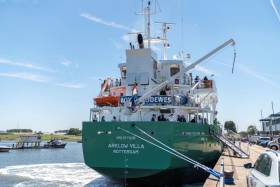Displaying items by tag: Final EcoTrader
#Ports&Shipping - Another progressive chapter for Arklow Shipping was notably marked on Monday as the final of 10 newbuild short-sea traders was christened at a ceremony held in The Netherlands, writes Jehan Ashmore.
Arklow Villa was christened in Delfzijl, where glorious weather conditions added to the celebrations as the 86m long hulled vessel built by Royal Bodewes was named. The occasion saw the newbuild use the 'V' naming theme with the cargoship berthed along the quayside close to the Ems Estuary, shared with neighbouring Germany.
The ceremony took place five days after the start of sea-trails began in the North Sea. Prior to these trials, the newbuild like all 9 sisters since 2015, beginning with leadship Arklow Vale were launched at the inland yard in Hoogezand and then towed on the canal network to Delfzijl.
Arklow Villa joins ASL's Dutch division, Arklow Shipping Nederland B.V. and likewise to all the Bodewes Eco-Traders, they fly the Dutch flag and have Rotterdam as a port of registry. The introduction of the newbuild brings to more than 50 dry-cargo and bulk-carriers in the combined Dutch-Irish flagged fleet.
Afloat has carried out further research to astertain that the maiden commercial voyage by Arklow Villa also took place on the day of the naming ceremony. This involved the 2,999 gross tonnage newbuild make a departure from the Dutch north-east port to Porsgrunn, Norway.
It is from the southern Norwegian port that the Royal Bodewes 5,170dwt Eco-Trader an in-house design from the Dutch yard, is next to sail to Belfast Harbour. Afloat also notes that the inaugural call to the Northern Ireland port is estimated to take place on Saturday.
As for cargo operartions, the hold is fitted with portable bulkheads that can be placed in 8 positions for cargo separation and storage. The hatch deck is equipped with a Coops & Nieborg pontoon system.
A main engine comprises of a MaK 6M25 1740 kW where through a controllable pitch propeller delivers a speed of around 12.5 knots.
For in port handing and when within confined spaces the straight-stemmed bow designed to minimise wave impact for fuel efficiency, is equipped with an electric bowthruster of 300 kW.























